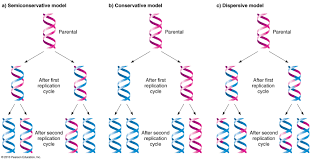Table of Contents
Introduction:
DNA replication is the process by which a cell copies its DNA before cell division. It is a critical process that ensures the accurate transmission of genetic information from one generation of cells to the next. There are three main models of DNA replication: semi-conservative replication, conservative replication, and dispersive replication.
Semi-Conservative Replication:
- Definition: Semi-conservative replication is a model in which each new strand of DNA is composed of one original and one newly synthesized strand.
- Mechanism: During semi-conservative replication, the double-stranded DNA molecule is unwound and each strand acts as a template for the synthesis of a new complementary strand. The two new strands are then rewound to form two identical double-stranded DNA molecules.
- Evidence: The semi-conservative replication model was confirmed by the experiments of Matthew Meselson and Franklin Stahl in 1958. They used heavy nitrogen (15N) and light nitrogen (14N) isotopes to label the DNA in E. coli cells. After replication, they found that each new DNA molecule contained one heavy strand and one light strand, demonstrating that each new DNA molecule was composed of one original and one newly synthesized strand.
Conservative Replication:
- Definition: Conservative replication is a model in which the original double-stranded DNA molecule remains intact and is used as a template to create two identical daughter DNA molecules.
- Mechanism: During conservative replication, the double-stranded DNA molecule is used as a template to synthesize two new complementary strands. The two new strands then rewind to form two identical double-stranded DNA molecules, while the original double-stranded DNA molecule remains intact.
- Evidence: Although the conservative replication model was once considered a possibility, it has been largely discredited by experimental evidence.
Dispersive Replication:
- Definition: Dispersive replication is a model in which the original double-stranded DNA molecule is broken into fragments, which are then used as templates for the synthesis of new complementary strands.
- Mechanism: During dispersive replication, the double-stranded DNA molecule is broken into fragments, which are then used as templates for the synthesis of new complementary strands. The new strands are then rewound to form two new double-stranded DNA molecules, with each containing a mixture of old and new DNA.
- Evidence: Although dispersive replication was once considered a possibility, it has been largely discredited by experimental evidence.
Conclusion:
In conclusion, semi-conservative replication is the most widely accepted model of DNA replication. This model has been confirmed by experimental evidence and remains the dominant model of DNA replication. The conservative and dispersive replication models have largely been discredited by experimental evidence and are no longer considered to be viable models of DNA replication.
